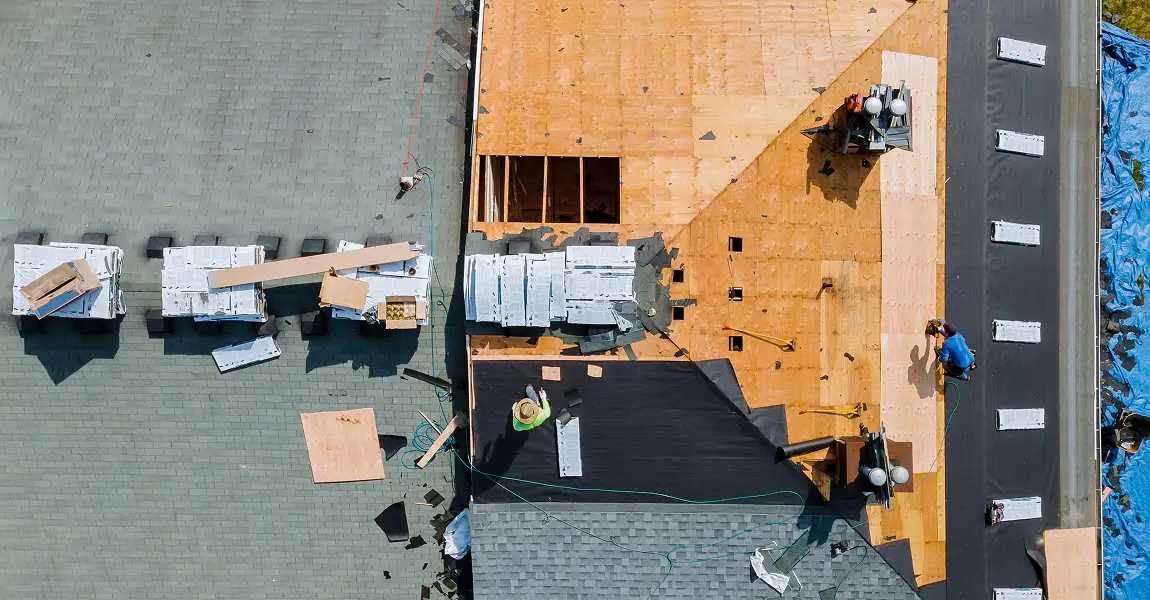A sturdy roof is essential to protecting your Raleigh home from rain, wind, and the city’s unpredictable weather. But no matter how well you maintain it, every roof has a lifespan. Knowing when roof replacement becomes necessary can help you avoid costly damage and ensure your home remains safe and secure.
At Citadel Contracting, we’ve worked with hundreds of homeowners across Raleigh—from North Hills to Wakefield Plantation—helping them make informed decisions about their roofs. Here’s a straightforward guide to understanding your roof’s lifespan and recognizing when it’s time for a replacement.
Know the typical lifespan of your roofing material
Different roofing materials last for varying lengths of time. If your roof is approaching the end of its expected lifespan, it’s a good idea to schedule an inspection.
Here are the average lifespans for common materials in Raleigh:
- Asphalt shingles: 20–25 years
- Architectural shingles: 25–30 years
- Metal roofing: 40–70 years, depending on the type of metal
- Slate and clay tiles: 50–100 years with proper maintenance
- Wood shakes: 30–40 years
We recently helped a homeowner in Raleigh’s Glenwood-Brooklyn neighborhood who had a 27-year-old asphalt shingle roof. Although it showed no visible leaks, the shingles were brittle, and granule loss was widespread—a clear sign that replacement was needed. If your roof is nearing these timeframes, it’s wise to consider a professional evaluation.
Look for visible signs of roof deterioration
Roof damage often starts subtly before becoming obvious. Regularly inspecting your roof—especially after storms—can help catch problems early.
Warning signs of roof deterioration include:
- Curling or buckling shingles: Shingles that don’t lie flat lose their protective function.
- Cracked or missing shingles: Missing shingles expose the underlayment, leading to leaks.
- Granule loss: Shingle granules collect in gutters when shingles start breaking down.
- Sagging areas: A sagging roof can indicate structural damage beneath the surface.
During a Roof Replacement project in Brier Creek, we found extensive damage under seemingly intact shingles. The underlying wood decking had started to rot due to prolonged moisture exposure. When you notice these visible signs, it’s time to act.
Check for water damage and leaks inside your home
Water stains, peeling paint, or a musty smell can indicate a roof leak. Water damage often starts in the attic before making its way into living spaces.
How to identify roof-related water damage:
- Check the attic after heavy rain for damp insulation or water stains.
- Look for discoloration on ceilings and walls, especially near corners.
- Watch for peeling paint or wallpaper, which can signal moisture issues.
- Inspect roof penetrations like vents and chimneys for signs of leaks.
A Raleigh homeowner near Umstead Park called us after spotting a brown stain on their living room ceiling. The cause? Cracked flashing around a roof vent. We repaired the flashing, but the insulation and drywall needed replacing. Catching leaks early helps avoid bigger headaches.
Inspect flashing around chimneys and vents
Flashing protects vulnerable areas of your roof, like chimneys, vents, and skylights. Over time, flashing can crack, rust, or separate, creating an entry point for water.
Signs of flashing failure include:
- Rust or corrosion on metal flashing
- Cracks in sealant around vents and chimneys
- Water stains near fireplace walls or ceiling vents
While working on a Roof Replacement in North Raleigh, we discovered that deteriorated chimney flashing had allowed water to seep into the attic for years. The homeowner had no idea until mold appeared on the ceiling. Regular inspections can catch these issues early.
Watch for moss, algae, and mold growth
Moss and algae aren’t just cosmetic issues. In Raleigh’s humid climate, they retain moisture against the roof surface, which can accelerate deterioration.
How to manage moss and algae growth:
- Trim overhanging branches to reduce shade and moisture buildup.
- Install zinc or copper strips along the roof ridge to deter growth.
- Schedule annual roof cleanings with a professional to prevent damage.
We once cleaned a moss-covered roof in Raleigh’s Five Points neighborhood. The moss had lifted shingles and allowed water to seep underneath. In some cases, cleaning is enough, but in this case, the damage required a full roof replacement.
Evaluate the roof’s structural integrity
Roof structures weaken with age and exposure to moisture. A sagging roofline is a clear sign of structural problems that often require immediate attention.
Signs your roof structure needs attention:
- Visible dips or uneven lines along the roof
- Cracking or bending in roof supports visible from the attic
- Walls or ceilings that appear bowed or warped
A homeowner in Raleigh’s Bedford community noticed their roofline looked uneven. When we inspected the attic, we found that the supporting beams had sustained water damage from a long-term leak. Replacing the compromised sections alongside the new roof restored the home’s structural integrity.
Consider the impact of recent weather events
Raleigh experiences its share of extreme weather—summer thunderstorms, occasional hailstorms, and even the rare ice storm. These weather events can cause damage that isn’t immediately visible.
How weather events affect your roof:
- High winds can lift or remove shingles.
- Hailstones cause granule loss and cracks.
- Ice storms create ice dams that force water under shingles.
After a spring hailstorm hit Wake Forest, we inspected several roofs and found damage that wasn’t visible from the ground. Insurance covered most of the costs for those who reported the damage promptly. If your neighborhood has been hit by a storm, schedule an inspection even if everything looks fine.
Monitor your energy bills for sudden increases
An unexpected rise in energy costs could indicate roof damage. Roofs contribute to a home’s insulation and ventilation. When they’re compromised, heating and cooling systems work harder.
Roof-related causes of higher energy bills include:
- Poor attic ventilation causing heat buildup in summer.
- Air leaks from damaged shingles or underlayment.
- Insulation soaked from water leaks losing its effectiveness.
A Raleigh homeowner in Stonehenge contacted us about rising AC bills. We discovered missing shingles had allowed water into the attic, soaking the insulation. After replacing the roof and insulation, their energy bills stabilized.
Check the condition of roof valleys
Roof valleys are critical because they handle the bulk of water runoff during rainstorms. If a valley fails, leaks often follow.
Signs your roof valleys need attention:
- Shingles in valleys are missing or appear worn.
- Granule buildup in gutters from deteriorating shingles.
- Water stains or drips near the valley edges.
In Raleigh’s Midtown area, we recently replaced a roof where an overlooked valley issue had caused water damage to interior walls. Valley repairs are often simpler and less expensive when caught early.
Conclusion
Understanding your roof’s lifespan and recognizing signs of damage can save you from costly repairs or unexpected replacements. From missing shingles to sagging rooflines, these indicators help homeowners know when action is necessary. Raleigh’s weather can be tough on roofs, so regular inspections and timely maintenance are essential.
At Citadel Contracting, we’re committed to helping Raleigh homeowners protect their properties with expert roof assessments and installations. If you suspect your roof may need attention, contact us today. We’ll provide a thorough evaluation and honest recommendations, whether you need a repair or a full Roof Replacement.
Frequently Asked Questions
How long does a roof typically last in Raleigh?
Most asphalt shingle roofs last 20 to 25 years. Metal and tile roofs can last much longer, with proper maintenance.
What are the most common signs that I need a roof replacement?
Look for curling or missing shingles, water stains on ceilings, and sagging rooflines. An increase in energy bills can also point to roof problems.
How does Raleigh’s weather affect my roof lifespan?
Raleigh’s hot summers, heavy rainstorms, and occasional ice storms can wear down roofing materials faster than in milder climates.
Can I extend my roof’s lifespan with regular maintenance?
Yes. Regular inspections, cleaning, and prompt repairs help maximize your roof’s longevity and performance.
Is it possible to repair a roof instead of replacing it?
In many cases, repairs are sufficient. However, if damage is widespread or the roof is old, a replacement may be the better long-term solution.
Why choose Citadel Contracting for roof replacements in Raleigh?
We combine local experience with high-quality materials and expert craftsmanship. Our Roof Replacement services are trusted across Raleigh neighborhoods.










